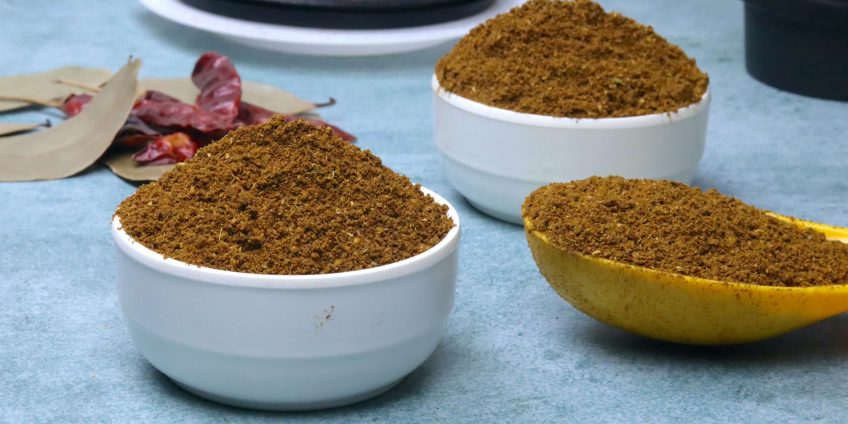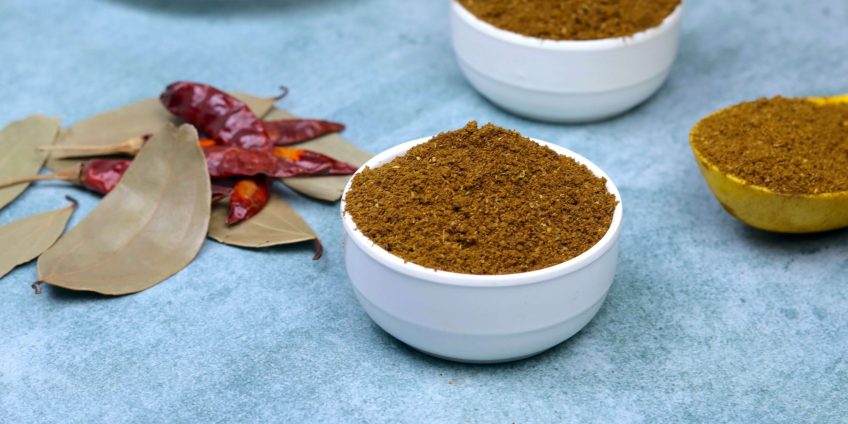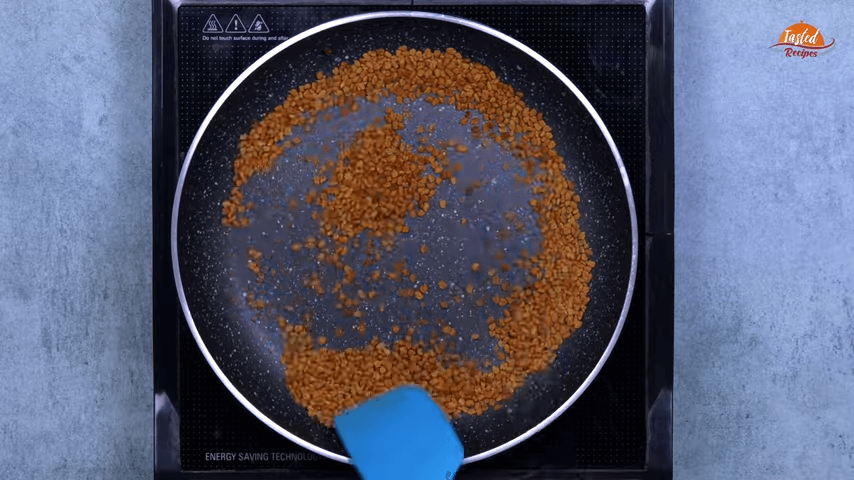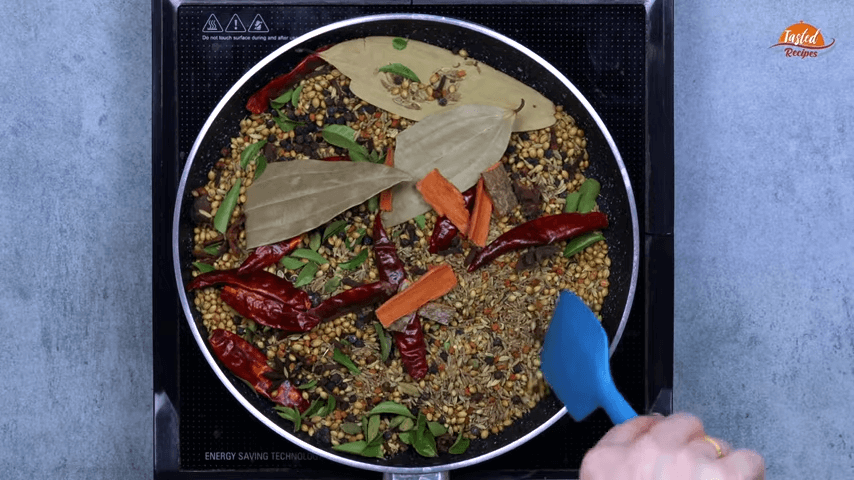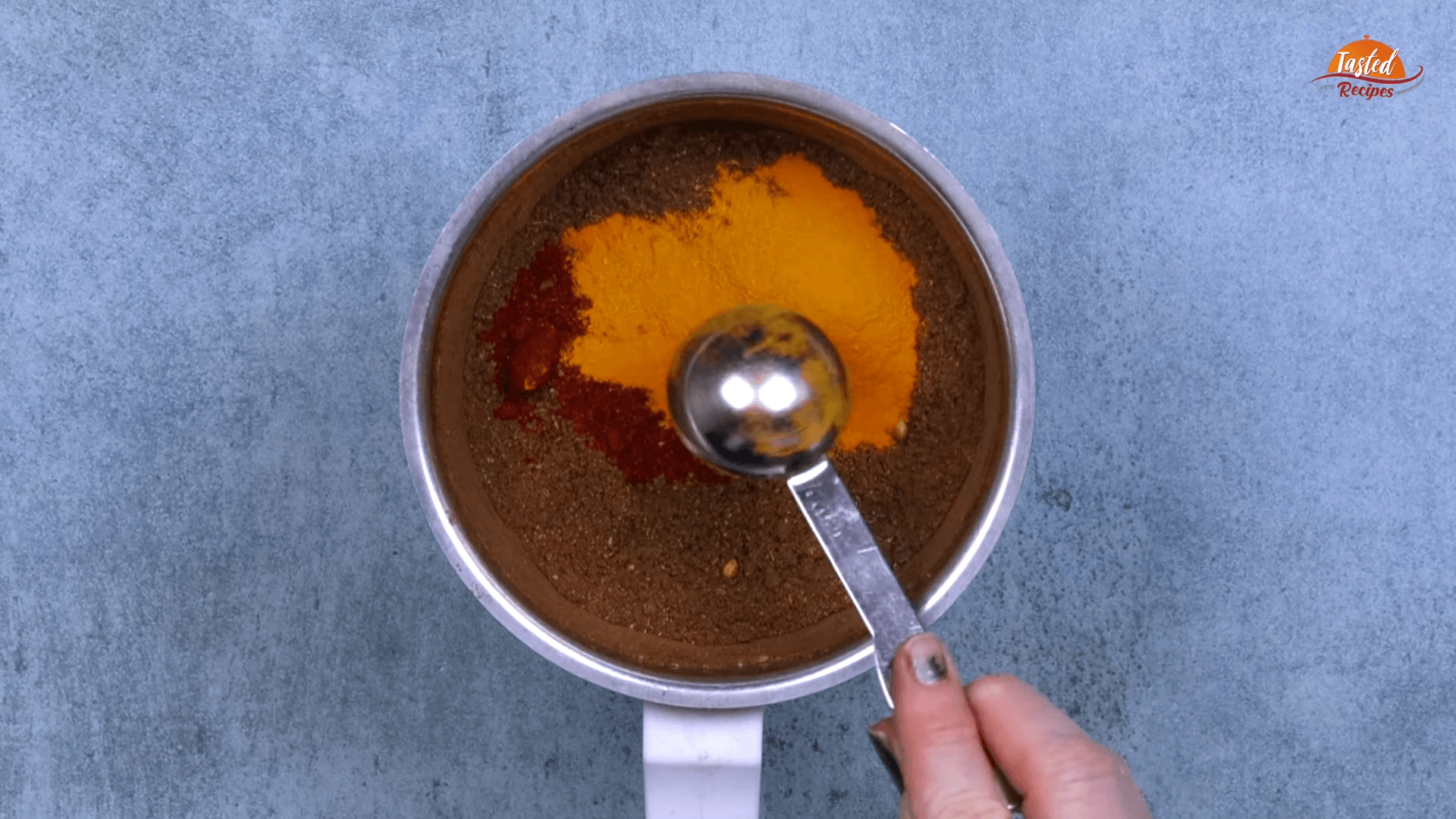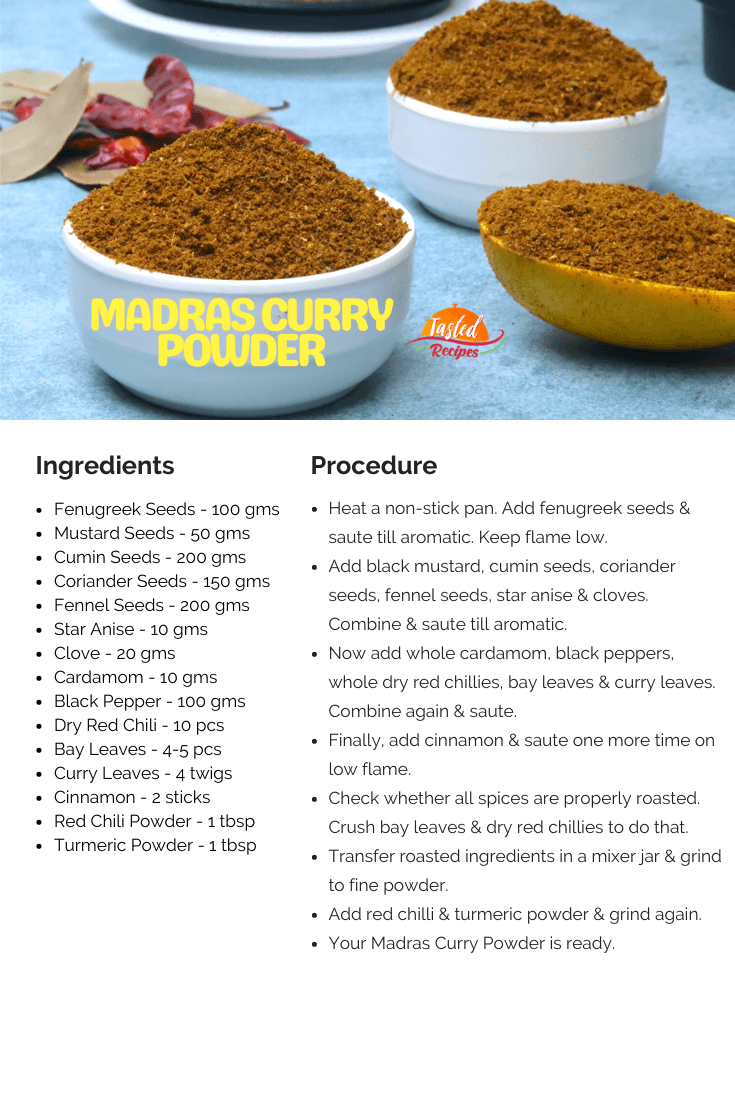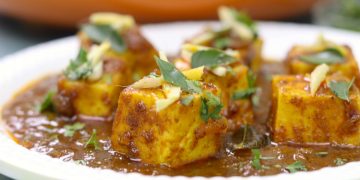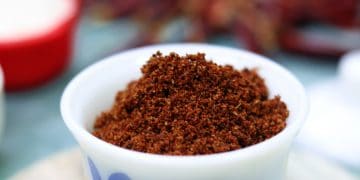Madras Curry Powder originated in the South of India. The curry powder got its name from the famous city called Madras (now Chennai). However, the legend is that the Britishers created it way before the South Indians did.
No matter who created but, we are lucky. We got the spiciest curry masala. And we are happy.😁😁
How Spicy is the Madras Curry Powder?
It’s important to realize that the madras curry powder is hot. जी हा ये मसाला पाउडर तीखा हैं, बोहत ज़्यादा नहीं लेकिन हें.😝 The reason why it’s extra hot & spicy is the heavy amount of pepper in it. Black pepper, clove, red chilli & others make it hot to handle.
So, in which recipe one can use the madras curry powder?
To begin with, all non-veg recipes. Yes, the non-veg items & the curry powder go hand-in-hand. The strong spices in this curry powder do a fantastic job. They not only enrich the taste but also tender the meat & poultry pieces.
Let’s go through the ingredient list.
What We’ll Add To Madras Curry Powder
A total of 15 items will be used to make this curry powder. All of them have a distinct taste, texture & aroma. Moreover, each one of them acts significantly to elevate the flavour of the curry powder. Here’s the list.
Fenugreek Seeds
The dry fenugreek seeds are bitter. Therefore, to reduce the bitterness, they are the first to go in the hot pan. Roasting them reduces the bitter taste & gives depth of flavour. Another key point is these seeds are stapled with Indian spices heavily used in Indian cooking. Thus, do not substitute it.
Mustard Seeds
There is a lot of variety in mustard seeds. However, we will specifically use black mustard seeds in our madras curry powder. It is essential to realize that mustard seeds have a strong, pungent flavour. That’s the reason why we will toast it. Typically, we do this in the tempering process by frying them in hot oil. So, either way, it helps us reduce the solid peppery taste.
Cumin Seeds
Jeera, aka cumin, is a versatile spice with a variety of uses. The taste profile of cumin is rich. Not only this, but when cumin is mixed with other spices, it elevates the flavour. For this reason, roasted cumin seeds are crushed & used as sprinklers.
Coriander Seeds
Coriander seeds have a subtle sweet & sour taste profile. As a result, it is used in both sweet & savoury recipes. Roasted coriander seeds provide a smoky aroma. That’s the reason why it is substantially used in both vegan & non-veg recipes. On the positive side, we have also integrated coriander seeds into our curry powder.
Fennel Seeds
Fennel seeds are sweet & aromatic. Additionally, it has a mild anise flavour too. Here in India, we primarily use them as mouth fresheners or mukhvas. The strong aroma of fennel seeds is the reason why we have used them in our curry powder. The flavour profile of fennel seeds is herbaceous. That’s the reason which makes it a versatile spice.
Star Anise
Natively known as chakra phool in India, star anise is popularly used in savoury recipes. The best part is the sweet-liquorice-peppery flavour. Not to mention, star anise is known to enhance the meat flavour. The reason being its strong taste. Now you can add it directly or blend it in with other spices to make it more flavourful. Either way, it gives excellent results.
Clove
Cloves are intensely aromatic spices with a subtle sweet flavour. As a result, they lend plenty of warmth to a particular recipe especially non-vegan dishes. Eventually, clove makes great pair with other mildly sweet spices—for instance, cinnamon & nutmeg. On the contrary, cloves are slightly bitter. Due to this reason, they counterbalance the sweetness.
Cardamom
Here we will be using the whole green cardamom. On the other hand, cardamom has a smoky, minty, menthol-like flavour. Given these points of taste profile, it works incredibly well in savoury dishes. Not to mention, the distinctive use of this spice is well-known across the globe.
Black Pepper
Black pepper has a woody & sharp flavour profile. It’s distinct. Similar to black mustard seeds, black pepper has a unique spicy taste. It is self-explanatory that pepper must not be used as salt. The number one reason is it is not a taste enhancer. In contrast, salt is nearly used in every recipe, including baking items, to enrich the flavour. Too much black will impart extra spiciness, which can ruin a dish.
Dry Red Chilli
Dry red chillies are usually grounded into fine powder for a variety of culinary use. Although this may be true, the aroma of whole dry red chilly is intense. Since red chillies are an integral part of veg & non-veg recipes, we will use them in our curry powder. Not only spicy taste but these chillies are popularly used to give your dish the red colour.
Bay Leaves
Bay leaves have a woodsy & pungent aroma similar to black pepper & mustard. At the same time, it intensifies flavour & smells the longer it cooks. Bay leaves pair well with a wide range of herbs & spices. For instance, cumin, cinnamon, basil, garlic, onion, parsley, rosemary, thyme etc., are a few to name.
The purpose of using bay leaves is to enrich the flavour of other spices in the recipe. That’s the whole point of including them in our madras curry powder.
Curry Leaves
We will be using fresh curry leaves here. Notably, this is the only ingredient that isn’t dry. Henceforth, dry roast the fresh green leaves. Roast till you can crush them with bare hands. Not to mention curry leaves have a distinctive taste & aroma. Here in India, we use curry leaves to prepare tadka, aka tempering. Thus, don’t skip them.
Cinnamon
Cinnamon has versatile usage. It is the world’s favourite baking spice, but there’s something more to it. Not only bakery product but it is also used in regular lunch & dinner recipes. Special mention is flavouring meat using cinnamon. This technique is used for ages. The taste profile of cinnamon is sweet & woody.
Additionally, it has a mild citrus flavour too. I highly recommend it and so don’t skip it.
Red Chili Powder
We will be using the red chilli powder for an extra spicy twist. The basic idea of using it here is to add the much-desired red glow & sharp teekha taste. Surprisingly, the chilli powder is our seasoning spice with a dry red chilli base. It is highly advisable to use & not to skip.
Turmeric Powder
Apart from health benefits, turmeric powder has a strong colour profile. So, turmeric is a natural colouring agent. Since it is a culinary dye, it is recommended not to skip it. Not only this, but the health benefits of turmeric are famous.
The reason why I don’t recommend substituting it in the first place is – One spice is always on the list of almost any recipe ingredients. Go with it.
Making the Madras Curry Powder
The making process is a breeze. In other words, it’s easy. There are no lengthy cooking, making or pre-preparation processes. It is essential to realize that we are making an ingredient here. Our curry powder is an item that will go into a variety of recipes.
Therefore, storage becomes a priority. I will certainly discuss how to store madras curry powder but first, let’s see how to make it.
2 Easy Steps to Make Hot & Spicy Madras Curry Powder
Let me point out the essential steps first. All you need to do is dry roast & grind. Yeah. That’s it.
- Dry Roasting all the Items – Roast all spices in a non-stick pan till they release their specific aroma. Keep the flame low, or else they will burn. There’s a pattern we need to follow. I am talking about which item you will roast in the beginning. Similarly, which one will be the last one to go on the flame? Follow my video for a better understanding.
- Grind them to Fine Powder – Once every spice is entirely roasted, remove them from the hot pan. Doing this will prevent the overheating process. Allow the whole spice mixture to cool down. Don’t completely cool the mixture. Use a powerful grinder to grind. Check the texture because we need fine powder. If not, repeat once more.
Bingo! Your Madras curry powder is ready.
Take the powder same as the size of black pepper & taste. It must tingle your taste buds. This curry powder is meant to be hot & spicy. Therefore, don’t skip any ingredients. Now let’s talk about storage.
How to Store Madras Curry Powder?
Generally speaking, cool & dry places are preferred to store powders. And our curry powder demands no less than that. Henceforth, use an airtight container. The curry powder will have lumps when exposed to air. Keep this in check.
The second and most important thing is the storage vessel. There are many options—for example, food-grade plastic containers, glass bottles, aluminium & steel Dabba.
Indian homemakers mostly prefer glass containers to store masala powders. An average Indian kitchen will have multiple racks with glass bottles of all sizes. All of them were filled with a variety of masala powders.
Plastic containers are usually a second choice to store masala & spices. The reason being plastic is not safe to keep food items for a long time. However, premium quality food-grade plastic is durable & safe. But that’s a different story.
As of now, we will go with glass bottles or containers with air-tight lids.
The Flavour of Madras Curry Powder
It’s UNIQUE in one word. The reason is the combination of savoury & sweet spices in there. Aromatic herbs like pepper, bay leaves, cumin & turmeric powder provide a deep earthy & woodsy flavour. On the other hand, sweet spices, like cinnamon & clove, add brightness & richness.
Like I already said above, the madras curry powder is hot & spicy. It’s because of the red chillies & other hot peppers in it. In short, the amount of pepper determines how hot your curry powder will come out.
Mild curry powders have black pepper. Whereas hotter ones usually have a base of whole red chillies & dry red chilli powders. All of them make your curry powder too hot to handle.😅😂🤣
Cooking With Madras Curry Powder
Your madras curry powder is an all-in-one seasoning. A step further, one can use all-purpose seasoning to flavour soups, stews, sauces, marinades, meat & vegetables. Not only this but there are a lot more untraditional uses of this curry powder. For example, you can season burgers, salads & egg dishes with it.
We have drumstick curry with coconut milk. Here you will get to see how madras curry powder is incorporated. Using this curry masala, one can flavour traditional Indian-style non-veg dishes too. All in all, this multipurpose curry powder is quite a thing you would not want to miss.
So, that was it with the madras curry powder recipe today. Watch the recipe video for precise details. Follow the recipe steps with images. Compare them side by side while cooking.
There’s a recipe card too. Download it on your smartphone & make this dish on the go. If you like this recipe, share it with your friends & family members.
Subscribe to our youtube channel for new food videos daily. See you in the following recipe.
